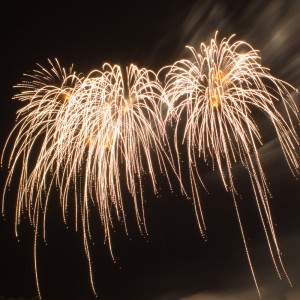Things that go BANG! The Science of Fireworks
A significant number of chemists and chemistry students are not in it for the money …. but in it for the explosions (and I am no exception). A secret hankering to be a fireworks engineer bubbles to the surface (or should that be ‘explodes into the atmosphere’?) every November 5th. Well, it’s time for some serious scientific explanation on how those beautiful fireworks make their display.
We will take a classic firework rocket as an example, which propels itself into the air then explodes in a shower of coloured sparks.
Rocket propulsion is achieved by the rapid expulsion of gases out of the base of the rocket. A fuel which burns quickly and produces large amounts of gas will, according to Newton’s third law, give the firework lift off. The force with which the gases are ejected downwards will produce an equal and opposite force upwards. This is Newton’s third law (sometimes stated as ‘every action has an equal and opposite reaction’). As long as this force is greater than the overall weight of the firework, the firework will accelerate upwards. The body of the rocket where the gunpowder burns must be strong enough to withstand the force of the gases being produced; the only outlet for the gases is in the base. The rocket’s body is also designed for stability in flight so it (hopefully) goes straight upwards.
The fuel commonly used to power rockets and be ignited by the fuse is gunpowder. It is a mixture of sulfur, charcoal (or carbon) and potassium nitrate, KNO3. The oxygen in the potassium nitrate means that gunpowder isn’t dependent on atmospheric oxygen to burn.
A simplified equation for the reaction of gunpowder is:
2KNO3(s) + S(s) + 3 C(s) → K2S(s) + N2(g) + 3 CO2(g)
The rapid production of 4 moles of gas for every 2 moles of potassium nitrate gives the ejection force necessary.
Once the rocket is airborne and the fuel is almost burnt, an internal fuse lights a second chamber within the rocket. The walls of this chamber are weak enough to break when the gunpowder (or other explosive mixture) explodes, scattering small burning pyrotechnic stars into the sky.
Pyrotechnic stars have a coating which burns easily, such as carbon, and a chemical mixture in the middle which gives a coloured flame or sparks when heated. Different elements in the chemical mixture of the star will give different colours when heated; the metal ion (cation) determines the colour.
| Element/Compound | Colour |
| Aluminium or magnesium | White sparks |
| Strontium or lithium carbonate | Red flame |
| Calcium chloride | Orange flame |
| Sodium nitrate | Intense yellow flame |
| Barium chloride | Pale green flame |
| Copper chloride (low temperatures) | Blue flame |
| Potassium nitrate | Lilac flame |
Be safe this November 5th and see how many elements you can spot.
